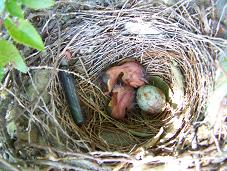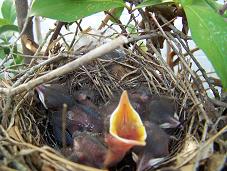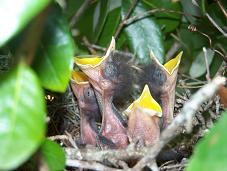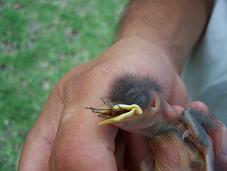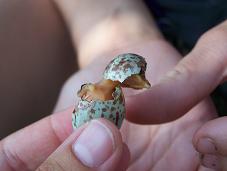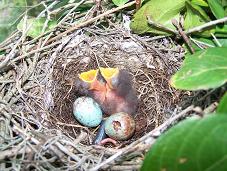by Monique Hiersoux
The adults of several bird species have been observed consuming the fecal sacs of their nestlings. A previous study on the American Crow and Florida Scrub Jay showed that the more nutritionally stressed parent, the female, consumes significantly more fecal sacs than the male for a given brood. This same study also indicated that the number of fecal sacs consumed by the parents decreases as nestling age increases. Furthermore, another study on the Mountain White-Crowned Sparrow showed that the nutritional value of fecal sacs decreases as the nestlings grow. These results led scientists to propose the “nutritional hypothesis”—that parent birds consume fecal sacs more often in early days of the nestling period because the nestlings’ digestive systems continue to develop for several days after hatching. Therefore, the fecal sacs are relatively high in nutritional value during this stage, and may benefit the parents by restoring energy lost during incubation.
The main goal of my project is to test the nutritional hypothesis in the field using the Northern Mockingbird as a test subject. Additionally, I want to determine the mechanism parent Mockingbirds use to determine when to consume fecal sacs, and when to dispose of them by carrying them away. My question here was whether parents visually cue on the nestlings or the fecal sacs in order to decide how to dispose of the fecal sacs. To answer these questions, I began by performing feeding rate observations on each nest during days 1-6 of the nestling period. Next, I performed fecal sac transfer experiments between nests. I transferred fecal sacs from older nestlings (approx. 8-10 days) to nests with younger nestlings (approx. 0-4 days), and vice versa. I recorded the behavior of the parents with respect to fecal sac disposal after each transfer. Additionally, I established two control groups. In one, I transferred fecal sacs from older nestlings to other nests with older nestlings. In the other, I transferred fecal sacs from young nestlings to other nests with young nestlings. In both control groups I recorded parental behavior. Finally, I collected fecal sacs from nestlings of all ages throughout the breeding season. I intend to analyze the fat and protein content of these and determine if there are changes in nutritional value with nestling age.
My results with respect to feeding rate indicate that parent Mockingbirds mainly consume fecal sacs until nestlings are approximately six days old. After day six, parents begin to dispose of nestling feces by carrying it away from the nest. With respect to the fecal sac transfer experiments, it seems that parents are making decisions about how to dispose of fecal sacs by visually cuing on the fecal sacs themselves rather than on the nestlings. The data indicate that parents would consume fecal sacs from young nestlings when it was placed in their nests with older nestlings. Furthermore, they would remove fecal sacs from older nestlings when these were placed in nests with younger nestlings. I intend to complete the project during the 2008 breeding season by performing more fecal sac transfer experiments in order to increase my sample size.
Back to Northern Mockingbird Projects
